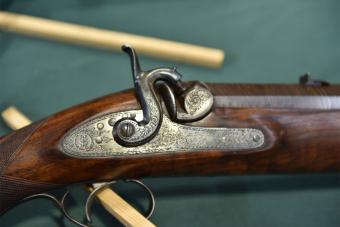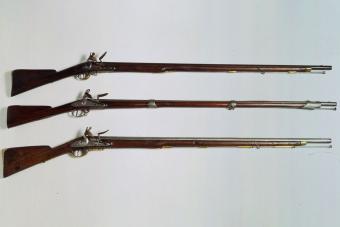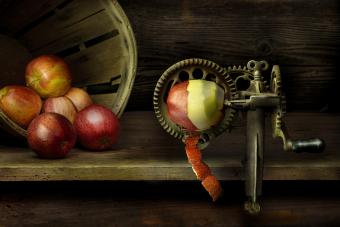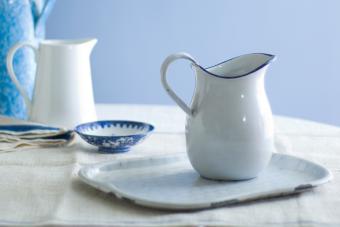
Antique flintlock rifles, with their rifled barrels and simplistic construction, harken back to a time where accuracy wasn't a guarantee. Although they're overshadowed by flashier historic firearms like lever-action rifles and tommy guns, flintlock rifles hold a significant place in history--and in some collectors' minds--because of their uncomplicated but impressive advancements.
The Flintlock Firing Mechanism Is Developed
Developed in the early 17th century, the flintlock mechanism quickly gained favor over the wheellock mechanism on firearms. Not only was the flintlock a much more reliable firing mechanism, but flintlock weapons were also much less expensive to manufacture. Based on simple principles, the flintlock mechanism worked through a series of cascading events:
- Cocking the trigger causes a hammer to fall forward and the steel striker, or frizzen, hits the flint.
- When the flint and frizzen hit, it causes small shreds to fall off and spark.
- The sparking shreds fall into a small charge of gunpowder in the priming pan and the powder ignites.
- The ignition of the small amount of gunpowder causes the main gunpowder charge in the barrel to ignite and the ball is propelled forward.
Although early flintlock firearms included pistols and muskets, it wasn't until the early 18th century that flintlock rifles began to step into the spotlight.
Flintlock Mechanisms Partnered With Rifling

Although rifling was first documented as early as the 1460s in Germany, throughout the 17th and 18th centuries, smooth barrel flintlocks were the norm and remained so for military use. However, there's a ton of evidence of American gunsmiths in the 18th century adding rifling to the barrels of their guns. Rifling--where grooves are cut into the metal inside the gun barrel--helps to keep the bullet stable when it exits the gun, ensuring that it doesn't ricochet off the last point of contact in the barrel and miss its target. In fact, in the 1720s, German craftsmen and gunsmiths living in Pennsylvania began designing and the building the forerunners of the very popular Pennsylvania, also known as Kentucky Long Rifle.
The main disadvantage of flintlock rifles was the "fouling" that took place. Fouling is the buildup of gunpowder byproducts that occur inside the barrel when rifling's present. Due to the way flintlock rifles were loaded, it became really difficult to load the tight fitting ball down into the barrel after several shots were fired. Shooters needed to clean their rifles very often to make sure that they'd work consistently, which made them a poor choice for a military weapon but an excellent choice for hunting on the frontier.
Identifying and Valuing Antique Flintlock Rifles
Oftentimes, identifying a flintlock rifle can be difficult since many of them were made by thousands of individual gunsmiths and small-operation manufacturing companies scattered across the United States. Typically, these rifles were unsigned, leaving a positive identification virtually impossible. However, both signed and unsigned rifles can undergo the same evaluation process to determine what their individual worths are. Some of the things that're focused on when these firearms are assessed include:
- Condition
- Construction quality
- Style
- Type and extent of decorative accents
- Probable maker
- Probable area where it was made
Tips for Evaluating Your Flintlock Rifles

Although you should always have your antiques appraised by a professional if you're planning on insuring them or selling them to a seasoned collector, you can definitely do your own evaluations at home to give yourself an idea of what kind of value you're working with. This is especially useful if you just want a ballpark idea of what you could probably sell your rifle for, and here are a few tips to get you started.
- Check the signatures - The signature on an antique gun's barrel is generally the signature of the gunsmith. If the signature appears on the lock, its usually the name of the manufacturer or supplier of the lock, not that of the gunsmith.
- Know collectors' preferences - Generally, flintlock rifle collectors in the United States prefer antique rifles made in America, followed by those made in the European countries of England, Germany, France and Italy.
- Look for signs of conversion - In the early 19th century, when the percussion firing mechanism was introduced, a great number of the flintlock mechanisms were converted into percussion rifles. Flintlock rifles that were converted to percussion rifles and then back to flintlocks have a lower value than those without any modulations.
- Determine the stock - Rifles with full stocks rather than half stocks typically have a higher value.
Flintlock Rifle Gunsmiths to Look For

Despite there being a lot of antique flintlock rifles out there bearing no maker's marks, those that do often come from the following makers and manufacturers:
- Springfield
- Griffin and Tow
- J.J&W.Jr HENR
- Harper's Ferry
- Baker
- J & W. Richards
- Parker and Field
- Hawkes
Antique Flintlock Rifles' Current Values

Generally, antique firearms of most kinds are worth around a $1,000 at a starting price, even if they have a lot of pre-existing damage due to weathering and storage conditions. That being said, antique flintlock rifles--whose manufacture spans at least 300 years--have sold for a couple hundred bucks to thousands of dollars at auction depending on a wide variety of factors. Specifically, when it comes to antique flintlocks, their condition is one of the most important factors in assessing their value. Things like patina, rusting, and the presence of replacement parts can either increase or decrease the monetary value substantially.
Additionally, provenance--the professional term encompassing the documentation proving ownership over the item's lifetime--and proven historical importance can turn an average old weapon into a money-maker. Flintlocks that were used in important battles or that were owned by significant people will garner a lot of collector interest and can bring in higher than normal rates at auction. Take these interesting flintlock rifles, for example:
- Federalist Isaac Tichenor's 1790s flintlock rifle - Listed for $7,475
- Rare 1824 Model 1817 flintlock rifle - Listed for $17,500
Examples of Flintlock Rifles
Many fine examples of these antique firearms are still found at auctions and from antique gun collectors and dealers. Depending on the specific piece, prices range from several hundred dollars to well into the tens of thousands.
For a better idea of what these many flintlock rifles look like, and to compare it to the one sitting in your collection, check out these retailers' inventory:
- Paul M. Ambrose Antiques - This retailer offers many flintlock rifles for sale, ranging in age and style.
- Michael Simens - Michael Simens, an antique firearms dealer, personally collects, appraises, and sells all manner of antique Kentucky long rifles.
Revolutionize Your Firearm Display
While antique flintlock rifles don't have the same flashy style that later firearms do, they're incredibly important thanks to steps they represent that firearm inventors took to increase accuracy and consistency. Of course, though you probably don't want to fire off an antique flintlock rifle at the gun range, they make for lovely mantle displays and perhaps for the occasional educational discharge.







